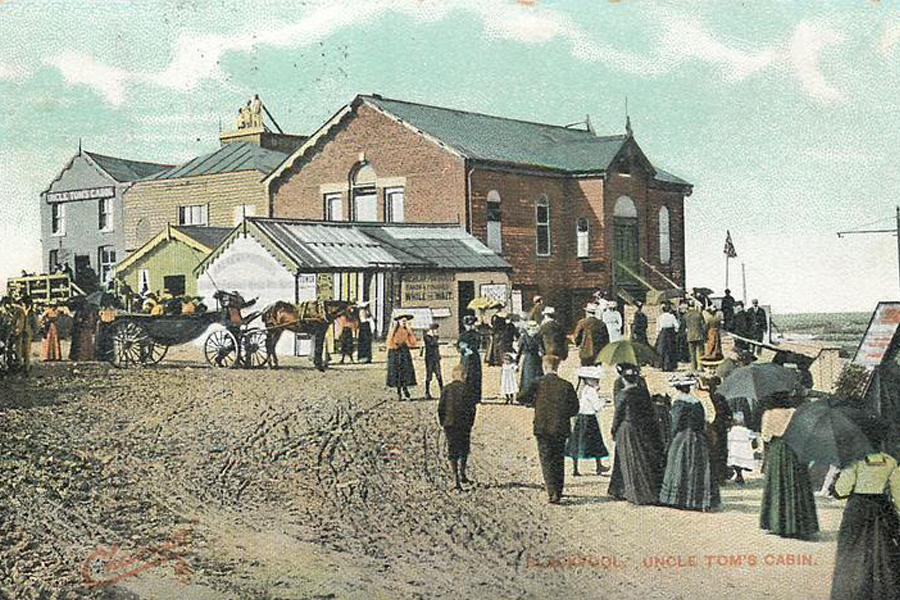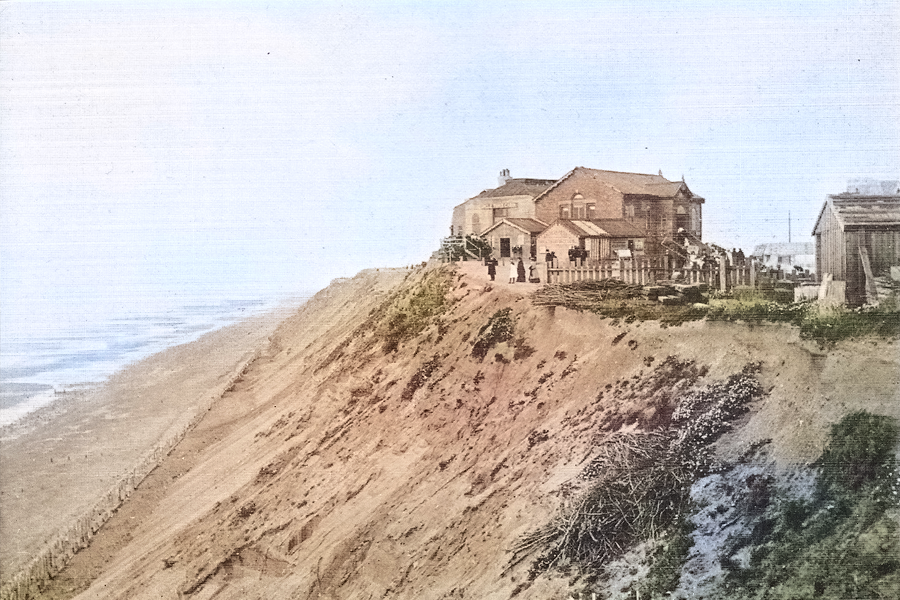
Uncle Tom’s Cabin, the pioneering entertainment complex, introduced the town’s first purpose-built dance floor, directly inspiring future landmarks like the Tower Ballroom and establishing the template for seaside leisure culture.
The World’s First Purpose-Built Dance Floor Open to the Public
Uncle Tom’s Cabin was not only Blackpool’s first purpose-built dance venue, but also one of the earliest places in Britain, if not the world, designed specifically to bring leisure social dancing to the masses. Decades before the famous ballrooms and dance halls of the twentieth century, its pioneering recipe of live music, dedicated wooden dance floor, and open access for ordinary people set the template for popular social dancing everywhere.
The forerunner of public social dance spaces, creating a new model for communal leisure and dance that influenced British culture
From Refreshment Hut to Revolutionary Dance Space
In 1850, Margaret Parkinson set up a simple hut near Blackpool’s North Shore cliff path, selling ginger beer, nuts and sweetmeats to seaside strollers. Her husband Thomas (“Old Tom”) soon transformed nearby cottages into a bustling refreshment house, earning a reputation as “Little London” thanks to its buzz of fortune-telling and leisure.
Capitalising on the runaway success of Harriet Beecher Stowe’s Uncle Tom’s Cabin in 1852, Old Tom renamed his venue to gain instant notoriety. Whether chosen for publicity or just to match the timber cabins, the name stuck, and so did the crowds.
Setting the Standard: The Golden Era
Quick to spot an opportunity, the Parkinsons expanded the dance experience by adding Cabin Farm, a neighbouring 20-acre site with swings, a switchback railway, amusements, and even an observatory. The “Cabin” soon regularly welcomed hundreds, and on holidays thousands, of visitors.
By the 1870s, the summer season spanned 18 weeks, with professional entertainers and a hired Quadrille Dance Band playing from morning till night. Dancing was the primary attraction, but guests also enjoyed cricket, gymnastics, and a range of family-friendly amusements. As Blackpool boomed, so too did Uncle Tom’s Cabin, attracting visitors from across the North of England.
How Uncle Tom’s Cabin Set the Stage for Dance Culture
Uncle Tom’s Cabin provided the world’s first mass leisure dance experience by combining:
- A dedicated, purpose-built wooden dance floor
- Live professional music, available daily
- Open access for everyone—not just the elite
- A festival-like mix of food, games, and relaxation
Its model, a public venue devoted to dancing, directly inspired dancing on piers, the explosion of Blackpool’s legendary ballrooms, and eventually the global dance hall phenomenon of the early twentieth century.
Birthplace of Blackpool’s First Dance Space
In 1850, Margaret Parkinson opened a simple hut near the cliff path, selling ginger beer, nuts, and sweetmeats. Her husband, Thomas, known as Old Tom, soon turned nearby cottages into a proper refreshment house. The place gained a reputation as “Little London,” thanks to its mix of seaside leisure and fortune-telling, and it quickly became a hub for day-trippers.
How Uncle Tom’s Cabin Shaped Blackpool’s Dance and Entertainment Culture
Old Tom had a knack for publicity. When Harriet Beecher Stowe’s Uncle Tom’s Cabin became a global sensation in 1852, he renamed his business after it. While Uncle Tom’s Cabin became a worldwide bestseller, it has since faced criticism for romanticism and double standards. The Blackpool venue opened soon after the book’s release, and the name might have been picked to cash in on its popularity, or perhaps for its link to minstrel shows. Some even suggest it referenced the timber buildings’ rough-and-ready look.
From Grass to Wooden Dance Floor
The name stuck, and by 1861, the venue had grown into Blackpool’s first real amusement centre. Visitors could dance on the grass to live bands, but soon, a purpose-built wooden dance floor was added. This made Uncle Tom’s Cabin the home of the very first purpose-built dance floor in Blackpool, setting a new standard for dance and entertainment in the resort. The site offered drinks, sideshows, and plenty of open space for games and relaxation.
Expanding the Dance Experience: Cabin Farm and Uncle Tom’s Cabin’s Golden Era
The business expanded to include Cabin Farm, a twenty-acre plot nearby, which welcomed school groups and excursionists. The grounds featured swings, a switchback railway, and even an observatory with a telescope for those willing to pay an extra coin. The farm and the main site together catered to hundreds of visitors each day, with numbers swelling to several thousand on special occasions.
By the 1870s, Uncle Tom’s Cabin was running 18-week summer seasons with professional entertainers and a hired Quadrille Dance Band that played from morning until night. Dancing was the main attraction, but there were also gymnastic displays, cricket, quoits, and plenty of space for families to relax. The clientele shifted from the lower-middle class to working-class excursionists, who arrived in droves on Saturdays and headed straight for Uncle Tom’s.
Uncle Tom’s Cabin: A Beacon of Blackpool Dance Heritage Through the Decades
In 1871, a local carpenter carved a wooden Uncle Tom figurehead and mounted it on the roof, adding to the venue’s quirky charm. The business thrived despite growing competition from other entertainment in Blackpool. The site even advertised for sale as a potential public garden or racecourse in the late 1870s, but no buyer was found, and the property remained in the hands of the original family for decades.
Challenges and Change: Relocating Uncle Tom’s Cabin and Preserving Dance Traditions
The venue’s success was tempered by practical problems. There was no direct road, so visitors had to walk or pay for a carriage to reach it. Worse, the cliffs on which it was built kept crumbling. Landslides in the 1890s and early 1900s caused serious damage. In June 1901, the smoking room fell into the sea, and further sections of the building were lost in subsequent years. The figurehead came down in 1903, and by October 1907, the original site was forced to close.
Uncle Tom’s Cabin relocated to Queen’s Promenade after the original cliffside building was forced to close due to erosion and collapse. The final demolition of the original site happened in January 1908. The new venue, also called Uncle Tom’s Cabin, opened on Queen’s Promenade in 1907, just before the original site was completely lost. It has operated at this location ever since.
Uncle Tom’s Cabin Today: A Living Legacy of Blackpool Dance and Nightlife
After its relocation to Queen’s Promenade in 1907, Uncle Tom’s Cabin continued to provide entertainment, though the transition marked a shift from its original cliffside outdoor amusement park atmosphere to a more conventional indoor venue. Over the decades, the new site maintained its reputation for hospitality and live entertainment, adapting to changing tastes and trends in Blackpool’s nightlife.
In the early years after the move, the venue retained its license for music and dancing, offering a mix of live performances and social events. As the 20th century progressed, Uncle Tom’s Cabin evolved into a well-known pub and concert hall, hosting live bands, cabaret, and themed social gatherings. By the late 20th and early 21st centuries, it had become a staple of Blackpool’s entertainment scene, renowned for its lively atmosphere and regular live music nights.
In 2017, the venue underwent a major renovation and reopened as Ma Kelly’s Showboat, part of the popular Ma Kelly’s chain. It offered a wide range of entertainment, including live cabaret shows hosted by Reece Oliver and featuring the Showboat Showgirls on Thursday, Friday, and Saturday nights. Dance-trained Reece Oliver, now the lead performer at Funny Girls under the stage name Miss CeCe D’Vyne, continues to be a central figure in Blackpool’s cabaret and dance scene. Just like the original 1850s cliff-top venue, during good weather, guests can still enjoy live music, dancing, and entertainment outdoors on the seafront terrace.
Uncle Tom’s Cabin’s Enduring Influence on Blackpool’s Dance Heritage
The site’s legacy is hard to overstate. It was Blackpool’s first purpose-built dancing space—the very first venue in town with a dedicated dance floor—and the prototype for the town’s later ballrooms and piers. The mix of music, dance, and seaside leisure that started here set the tone for Blackpool’s future as a resort. Even today, you can see echoes of Uncle Tom’s Cabin in the town’s vibrant nightlife and entertainment scene.
You can’t keep a good venue down, even if the cliffs keep trying.
Key Historical Significance:
- Architectural innovation: First dedicated dance platform in Blackpool
- Cultural catalyst: Introduced structured social dancing to the masses
- Entertainment blueprint: Combined music, drinks, and dancing decades before ballrooms
- Enduring influence: Design elements replicated in later venues like the Winter Gardens
This foundational establishment not only launched Blackpool’s dance culture but also demonstrated remarkable resilience in the face of geographical challenges and cultural shifts, preserving its entertainment legacy across three centuries.



